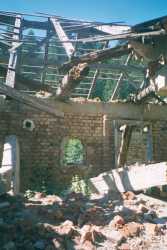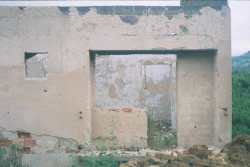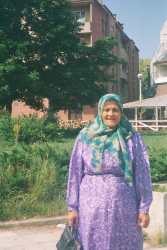Danica Borkovich Anderson, CCCJS 16713, B.C.E.T.S
I remember how NATO’s SFOR tanks rolled along the highways in Bosnia. One Bosnian highway is aptly called “Death Highway,” because of the bombed and burned-out shells of the homes which press against the road. It was March, 1999 and very cold in Bosnia. I had been invited to carry out clinical work in connection with trauma, with Bosnians who ran an organization called “Medex Mine Awareness”. Medex is a non-governmental agency which teaches a curriculum for children to survive the more than three million landmines in Bosnia. A part of me suspected that I would be facing a difficult clinical situation working in Bosnia. I went anyway. Compassion fatigue started to set in soon after my first trip to Bosnia in March, 1999. I would experience burn-out, just like the bombed buildings. It was like looking into a camera lens, and re-focusing the lens when I found myself embarking on a very sacred pilgrimage, fully equipped with my Bosnian mother tongue as I walked along war-weary and destroyed roads, villages, and homes. I was definitely off the beaten track in Bosnia, and I knew I must have been summoned here to learn something very important.

Recreational Center near Mt. Vlasic off of “Death Highway.”
I did not know what I was called to do at the time, but I felt that the reason would soon unfold. I did not know that I would experience compassion fatigue, and that I would not be able to distance myself from the traumatized Bosnians with whom I was working. My Bosnian American Serb cultural background and my understanding of the language immersed me deeply into the Bosnian situation, and I found myself traumatized each time I set foot on Bosnian soil. Yet, I knew my strengths in treating trauma in Bosnia were my Bosnian heritage, and mother-tongue skills, along with my experience in trauma treatment. I didn’t know at the beginning that I would need to remember to view those skills as an asset, rather than as a liability.
NATO’s bombing of the Republic of Serbia heralded my development of a cultural clinical trauma treatment immersed in feminist archetypal psychologies. I worked long days and nights whenever I went to Novi Travnik, Bosnia. I now recognize that compassion fatigue’s common companion is workaholism, with burn-out ensuing shortly thereafter. All I knew at the time was that the constant work tuned out disturbing messages. I would do self-talk and justify how much work there is to do in Bosnia so that I could work the 24-hour shifts which inevitably took place whenever I was there. I was numbing myself in an exaggerated fashion.
Like most Bosnians, I worked, but I also did not have the vocabulary to express the trauma and horror that my eyes or my ears absorbed as I heard the first-person stories. As I surveyed the town of Novi Travnik, I was traumatized by what I saw. The Bosnian women that I worked with were already vulnerable from PTSD; most Bosnian women are refugees, joining 23 million refugees as of March 1995 (Mertus, Tesanovic, Metikos, & Boric, 1997 ). The civil war in Bosnia took over 200,000 lives, and left 3 million refugees without their homes (Mertus et al, 1997). I was in a soup, comprised of traumatized peoples, and I rarely had the opportunity to talk to a non-traumatized person. This made me grow more silent with each experience I had. I could not share what I saw, what I felt, or what I heard.
All of these factors have strongly influenced Bosnian women, including myself, to remain silent, and to maintain victim status. Silence does not increase vocabulary, or promote an expression of first-person story. I was experiencing an utter lack of words which could appropriately describe the depth of what I was experiencing.
I actually started to acknowledge that each time I worked in Bosnia, I was colluding with truth. Sometimes, I wished for bombs to hit the grenade-damaged homes that now had trees growing in them. I wanted to erase this violent statement of burned and assaulted homes, and I wanted to avoid anything “religious,” because all of that depicted hatred of anything feminine. Disturbing thoughts and violent schemes that entertained these types of “solutions” were another signal that I was experiencing compassion fatigue.

“Taken in Novi Travnik where I work.”
I was jarred into realizing the unexamined maw of those disturbing thoughts by a young Muslim woman who, upon realizing that two Muslim women in Novi Travnik had been mutilated and sexually blinded, pleaded for answers. Her plea of, “How is a razor blade an indication or a representation of my Muslim faith?” catapulted me into awareness. I ended up speaking to her about how a solution such as a razor blade or erasing a woman’s sacred feminine with violence was never an answer. I felt I had answered myself. I began a probing examination into my own disturbing thoughts. I felt attacked from every angle as a woman, and therefore I did not feel any sense of safety or trust. I was uncomfortable being a victim. With my disturbing thoughts, I was mutating from a victim to an attacking offender. I knew this was an indication that I was in the cycle of violence.
I felt traumatized each time I walked the Muslim sector of Novi Travnik. When I work in Bosnia, I lived with the women. This meant that I faced the Bosnian women’s issues of having no work, no food, or no money to live on. There are no laws against domestic violence or child abuse in Bosnia. Bosnian women maintain a brotherhood (not a sisterhood, since most have not ever experienced solidarity with women) with the violence, thus ensuring that the intergenerational aspects of trauma continue to be a part of their lives. For instance, in the women’s kolos, in their circles (in Bosnian, “kolo” means ” a circle” or “to dance,”), one would often hear one Bosnian woman complaining about her screaming neighbor. The Bosnian woman would comment loudly about how the woman simply did not clean her house well enough for her husband – this justified her nightly beatings. Bosnian women, unable to support other women, and unable to truly understand that women are the target for all androcratic reactions, join the brotherhood by finger-pointing, and by being in isolation from one another. The silence and lack of support for each other was deafening.
I became intimate with their life, and therefore with their trauma. The intimacy meant that I could feel compassion and empathy, while seeing how my own childhood traumas were similar to the traumas the Bosnians were facing. Carefully and conspicuously, I recorded what was happening to my womanhood or to anything remotely feminine in that context. The feminine was being systematically raped, maligned, and feared by androcratic violence, a cult of hatred that is deeply rooted into the Southern Slav way of life. Being a female in this world, regardless of the land of your birth, is usually a journey into violence, and thus working in this environment had me working on many of my own unassimilated and unexamined female issues.
As a trauma psychotherapist, I already knew that statistics demonstrate that most perpetrators of violence are male. As a daughter of Bosnian immigrants, I intimately knew from first-hand experience of the raw violence that is meted out towards women because women are nonentities. As a therapist, I heard many women vehemently resist the term “feminist,” let alone utter the word “Goddess”, because any such acknowledgement would render them less “feminine” according to the male point of view, and then they would become real targets of the patriarchy. Until my clinical work in Bosnia, I had no idea how violent all this unconsciousness of the feminine could be. Nor did I know that I would be painfully conscious of every detail that fed into the violence cycle. This meant I virtually never rested, nor was I ever really at peace.
As I walked their steps and streets, I knew that the most effective trauma treatment would need to edit out all the warrior male-centered symbology so prevalent in their current culture; the cult of the male reigns supreme in Bosnia today. I am one of 2.5 million American Serbs in the United States, and I was raised in the very same warrior male-centered cult in Chicago, Illinois. The child abuse I suffered in my childhood, and the abuse that so many American Serb children of my generation suffered, taught us all that the war never stopped, and that it was continued through the generations. I do know from my work in Bosnia that this was perhaps the single most important driving force to my becoming a forensic therapist. It also was a significant factor in my compassion fatigue.
I would find myself constantly asking in disbelief how the violence continues to be perpetuated, whether in the Serbian Orthodox enclaves of the United States, or in Bosnia. Working in Bosnia ensured that I went through another therapeutic process in connection with my family of origin issues, especially in terms of my mother, who stood by and watched, and did nothing about the abuse. I remember sitting in a large hall with the Bosnian women and feeling haunted by my mother. Every single one of the Bosnian women mirrored an intimate trait of my own Serbian mother.
I was hearing the voice of my mother in my childhood when I worked with the Bosnian women. I was feeling the brutal blows of my Bosnian Serb father when I had sessions with the men who spoke of their war atrocities. I thought of how the landscape holds memories, just like the body does. My childhood with its traumas was my internal geography, as it was for these Bosnian women and children. I realized I was negotiating the same landscape of trauma as the Bosnian refugees were.

“Taken in Novi Travnik where I work.”
It was harder and harder for me to return to Bosnia, because I found the geography of their trauma perilous, and too close to my own Bosnian American childhood traumas. At a deeper level, I recognized how the Bosnian women had no such choice of deciding when to return to this landscape and internal geography, since they physically live in a war-torn land. This is just like children, who do not know choice as abuse or trauma rains down on their bodies and spirits. I felt frozen, not completely able to understand their position.
I would try to move forward from this frozen geography through choice. I recognized that I had an awareness of choice. I sought help in clinical supervision and in therapy. I would adjust my calendar in Bosnia to do daily exercise, to carry out journal writing, and to practice meditation. Conscious that healing the effects of post-traumatic trauma requires that the first-person story be told and expressed as soon as possible after the traumatic event (Ochberg, 1988), I started to write articles about my experiences in Bosnia.
Since Feminist Archetypal Psychology practices are applied in my work and are interdisciplinary, I took note of the need for “first stories” of suffering as a rite of passage to a wisdom that introduces the individual into a “new way of being” (Borysenko, 1993). This meant that my suffering transcended into meaningfulness, helped by my journal writing. A “time-out” to exercise my body refreshed my mind/spirit; this helped me to become more aware that I had a choice; I became able to disengage from the trauma all around me for brief interludes.
Being more mindful of my intention made me aware of the need to understand how trauma can penetrate and bleed into my own personal experiences. As I reviewed the clinical work in Bosnia, I noted some important cautionary signs that, in the future, would help me to take the suffering into meaningfulness, rather than into compassion fatigue: using work or working excessively to avoid looking at your issues or emotions. This is “numbing” oneself, and is often expressed as substance abuse or other addictive behaviors. Overeating, or not eating , and chain-smoking are other examples of this kind of thing;
the blurring of boundaries, and being immersed into a situation, or closely identifying with the individuals – that is, sharing a common history or traumatic events.
being unable to share or express first person story – lacking a vocabulary or feeling that “no one would understand”, or that “no one cares enough to actually listen.”
Working with my own uncomfortable feelings, while working with severely traumatized peoples required my utmost attention to “dailiness.” By focusing on my daily activities, I was setting limits in terms of what was humanly possible to achieve. More importantly, I was able to record the emotional facts that I was intensely experiencing, whether it was in my journal writing, my conversations with my support community, or jogging down Bosnian country roads. After jogging one morning in Bosnia, I remembered how I felt I was moving from an unconscious state to a very focused and aware state. Sometimes, after these periods of reflection, I literally stopped in my tracks! And this was definitely needed.
I eschew self-help programmed directions, because they seduce a person into thinking that there are proscribed steps for life situations. My reasoning and experience tells me that every person is unique, therefore no set of generalized steps are the answer. I do feel that it is extremely important to share one’s life experiences, because everyone learns from how other people have handled different situations. No book, no computer, and no school can compare with the humanistic sharing of one’s life. What I learned in my situation was how I can always garner an increasing set of valuable life-coping skills and tools that will keep me healthy in my life experiences, even when I am working with traumatized peoples in war-torn environments. My garnered life skills and tools from this experience are: the ability and awareness to seek help. This is critical. A good therapist is a part of a healing and supportive community that every individual needs to be surrounded with while experiencing any kind of trauma. I discovered other resources in the helping professions through avenues such as the Internet, and through my professional organizations. One Internet search led me to this very website, “Gift From Within,” which greatly encouraged and supported me at a time when it was very needed.
developing and always enhancing your support community and family/friend base. I now have friends from the humanitarian fields, and not just in the mental health fields; we can share our experiences, and increase our vocabulary to express ourselves. Listening to their responses to my first-person story is imperative, even if at times you prefer not to hear what they are saying. My life skills of always having a community were updated and expanded, and I now have an increasingly diverse support community and an array of friends.
keep to your daily activities on your calendar, even if you do travel or are not at home. For myself, I recognized how my daily activities were in essence “spiritual practices,” not rigid routines that can be deadening. A rigid routine is compulsive, and also an indication that you are numbing yourself in an addictive fashion. Journal writing or meditating for 30 minutes daily, along with walking, jogging or yoga, center a person and give focus and direction. When I did my “daily” spiritual practices, I found that I actually also scheduled in times for “fun” activities. When I traveled, I tended to forego my spiritual practices. Now, I make sure I enable myself to conduct my spiritual practices, even if they are modified and altered.
To this very day, I continue to work with the Bosnian refugees, but under healthier conditions and limits. I found that when I tried to be specific with my traumatic experiences I not only gained a vocabulary I gained more focus by taking care of myself. I was stunned when I modeled self-care the Bosnian women came to know what they were doing and not doing in their traumatized lives. I never had to speak a single word, show a self-help video or get a guest speaker in to dramatize the need for these women to take care of themselves hence their family started to heal and with the final outcome their community started to heal. A dark haired Muslim mother, who leads the kolo-circle organized a strike with other mothers about the mounting garbage in the streets. This is not a small feat to go up against the ruling governments rife with pilfering pockets. The Muslim mother waited until I had left to do the strike. She and other Muslim women wanted those in power to realize this strike was all theirs and not from an American!

I have been photographing many Bosnian witches-Vila.
This is what they remind me of.
I saw a glimpse of solidarity amongst these Bosnian women striking about the garbage and this is an indication of health rising up from the depths of suffering. At times I have felt such resignation and hopelessness working in a war-torn country with traumatized peoples. I felt despair with the utter apathy and neglect about the situation of women in Bosnia, across the globe to the streets in my neighborhood. I was often slapped with the reality that no one did care what happened in Bosnia because it was not in their backyards. But when I saw these glimpses of solidarity with the Bosnian women or women who wanted to come to Bosnia with me because they did have empathy and wanted to rise from their own depths I felt renewed and motivated. Isn’t the force of our life experiences and feelings that ride along with these life experiences our universal humanity that connects every one of us together? I only know for myself the work I do on that sacred Bosnian landscape riddled with terrible wars became a pilgrimage to the center of my being. And it was not easy. And it was beautiful at times. And it is a process not something to achieve or attain like goals at a hockey game.
In fact, the process continues to grow with my clinical work in Bosnia. Together with the Bosnian women, I am preparing a second annual conference this October. The clinical format of the kolo has developed self-sustaining psychological and economic activities, such this annual conference held in Novi Travnik, Bosnia. The second annual conference “First Person Story,” is this October 20, 2001 for 10 days. You are invited to come and bear witness to these women and their first-person stories. The first seven days of the conference tours the body of Bosnia. The second portion of this unique conference – the last 3 days – has the participants hearing the Bosnian women’s first person stories as they speak them. The conference allows one to either participate in the entire ten-day program or the three-day conference segment. This year’s conference participants joining the group will be guided by Patricia Reis, feminist archetypal therapist and renowned author, along with Anne Yeoman, another seasoned therapist from the Boston area. All the funds go directly to the Bosnian women hosting the conference.
More information on Danica Borkovich Anderson and the Kolo:
The kolo is an engendered clinical trauma treatment program for Bosnian women and other victims of Post Traumatic Stress. The word “kolo,” when translated, means “circle” or “to dance” in Bosnian. The kolo can be described as being a geosphere. Kolos are literally micro-geospheres of Mother Earth, are a natural form, and provide a structure for a source of sisterhood for Slavic peoples. Employing Feminist Archetypal Psychology practices because they are interdisciplinary, Danica was able to utilize the rich resource of “Old Europe” and her ethnic heritage by spinning through the fields of archeology, archeomythology, ecology, women’s studies, and psychology.
Danica Borkovich Anderson, Executive Director of The Kolo: Women’s Cross Cultural Collaboration, integrates Social Justice in War Conflicted Zones, Catastrophes & Emergency Situations with an International Feminist Perspective which engenders approaches and major policies concerning traumatized populations. She is one of nine consultants with the International Criminal Court in the Hague, a Gender Psycho-social Victims Expert. Internationally renowned leader and researcher Danica Anderson with her background in forensic psychotherapy and a Fellow in the Academy of Trauma Experts, addresses the challenges of integrating diversity, multicultural issues with a ‘feminine lens’. Ms. Anderson is skilled at grassroots efforts with native local female populations in war scarred landscapes to embrace female human rights, to heal their community, become self-sustaining and continue the work outside dependency issues. The Kolo: WCCC focuses on intersecting women’s advocacy, representation and gender justice to halt gender violence both nationally and internationally. Her website is www.kolocollaboration.org, email: danica_kolo@yahoo.com
- Mertus, J. Tesanovic, J., Metikos, H., & Boric, R. (Eds.) 1997. The Suitcase: Refugee voices from Bosnia and Croatia. Berkley, California: University of California Press.
- Frank M. Ochberg, M. D. 1988. Post Traumatic Therapy and Victims of Violence. Brunner Mazel Publishers.
- Joan Borysenko, Ph.D. 1993. Fire in the Soul, Time Warner, Inc., New York.
 PDF [63KB]
PDF [63KB]
Other important references:
DVD- PTSD & Veterans: A Conversation With Dr. Frank Ochberg
How do we help our veterans who are returning from war with PTSD? Our DVD provides an intimate conversation with Dr. Frank Ochberg, as he shares his experiences, seasoned insights and suggestions. This program is for the mental health practitioner who has treated a variety of clients including those traumatized by abusive relationships, sexual assault, disasters, Sept 11, and violent crime. Dr. Ochberg feels that treating veterans is a privilege and he shares his experiences dealing with veterans from the Vietnam era, Afghanistan and Iraq. He welcomes those therapists who are supporting our returning men and women as they adapt to civilian life.
DVD “When Helping Hurts: Sustaining Trauma Workers.”
Danca Anderson: “After the Bosnian Women’s conference, the participants spoke of how utterly clear the “When Helping Hurts,” tape became for them when dealing with the aftermath of touring the body of Bosnia. I found the information and sharing on the video “When Helping Hurts,” to be instrumental in signaling the need to get help in dealing with my compassion fatigue.”
“Compassion Fatigue: Coping with Secondary Traumatic Stress.” Charles Figley, (Amazon rating 3.5 stars), $48.95.
